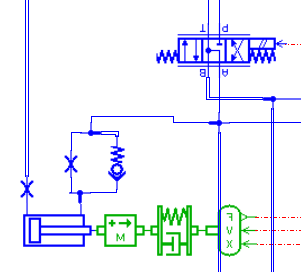Within the short duration that a high pressure hydraulic value open very large hydraulic pressure and flow rates can develop within an aircraft hydraulic network. These pressure waves cause the effect known as waterhammer and often lead to added fatigue on the pipe network, burst pipes, or cause even violent movement the network pipes leading to pipe brackets failing.
Hydraulic equipment must be designed to suppress these hydraulic transients.
Skynetics has a proven capability analysis this effect, and designing equipment with suppression technology to mitigate these harmful effects. In the example below, the time histories on the top graph demonstrates the opening of a 5000psi (350 bar) valve. The valve opens to pressurize a length of tubing initially at low pressure. The maximum waterhammer pressure is 7000psi [490bar] and significantly above acceptable values.
The time-history on the bottom is the same system with waterhammer suppression which has reduced the peak pressure to 5500psi [385bar] which is only a 10% overshoot.
This phenomena is often observed during laboratory test or during aircraft testing at which time re-design is costly and timely. Analysis methods developed and used by Skynetics can assist correct valve design to mitigate this problem early in the design process when costs are minimized and ensuring an optimised design is still achieved.
The analysis methods used by Skynetics have been validated by test and equipment is presently in-services on aircraft.

| Cookie | Duration | Description |
|---|---|---|
| cookielawinfo-checkbox-analytics | 11 months | This cookie is set by GDPR Cookie Consent plugin. The cookie is used to store the user consent for the cookies in the category "Analytics". |
| cookielawinfo-checkbox-functional | 11 months | The cookie is set by GDPR cookie consent to record the user consent for the cookies in the category "Functional". |
| cookielawinfo-checkbox-necessary | 11 months | This cookie is set by GDPR Cookie Consent plugin. The cookies is used to store the user consent for the cookies in the category "Necessary". |
| cookielawinfo-checkbox-others | 11 months | This cookie is set by GDPR Cookie Consent plugin. The cookie is used to store the user consent for the cookies in the category "Other. |
| cookielawinfo-checkbox-performance | 11 months | This cookie is set by GDPR Cookie Consent plugin. The cookie is used to store the user consent for the cookies in the category "Performance". |
| viewed_cookie_policy | 11 months | The cookie is set by the GDPR Cookie Consent plugin and is used to store whether or not user has consented to the use of cookies. It does not store any personal data. |